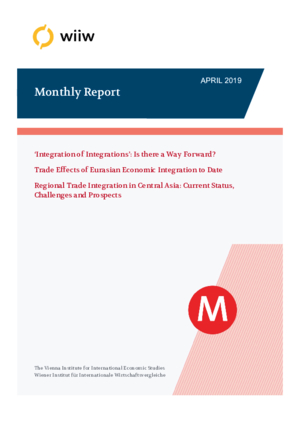Monthly Report No. 4/2019
Amat Adarov, Vasily Astrov, Alexandra Bykova and Olga Pindyuk
wiiw Monthly Report No. 4, April 2019
45 pages including 32 Figures
- Chart of the month: Remittances in CESEE countries, as % of GDP in 2018
by Vasily Astrov
- Opinion corner: ‘Integration of integrations’: Is there a way forward?
by Vasily Astrov
Technically and given the political will, economic integration between the EU and the Russia-led Eurasian Economic Union (EAEU) should not be overly difficult to implement, and there are good reasons to believe that it could be beneficial not only for EAEU countries but also to some extent for the EU. However, realistically this may require a change in the current political elites either in Russia or in the EU (or both).
- Trade effects of Eurasian economic integration to date
by Amat Adarov
Eurasian economic integration was initiated in 2010 with the establishment of the Eurasian Customs Union, and its successor, the Eurasian Economic Union, was formed in 2015. However, there is still little awareness about the economic content of the Eurasian bloc, rather often seen as a ‘paper tiger’ and a geopolitical project led by Russia. Likewise, empirical analysis of its actual impacts to date is lacking. The article reviews key developments to date and trade-related effects associated with the Eurasian integration. The economic outcomes are mixed, with Belarus being a major beneficiary, Russia generally gaining and mixed performance for Kazakhstan. The positive effects of integration on mutual trade, while initially notable, diminished significantly towards the year 2015.
- Regional trade integration in Central Asia: Current status, challenges and prospects
by Alexandra Bykova and Olga Pindyuk
Trade integration in Central Asia remains rather low, only Kyrgyzstan is relatively well integrated with the region. The reasons behind this are (i) a low degree of complementarity and export specialisation in natural resources; (ii) deficient transport networks; (iii) low quality of institutions and diverging trade policies; and (iv) political conflicts regarding border delimitations and resources management. However, the situation seems to have changed recently and interaction among the regional states has intensified considerably.
- Monthly and quarterly statistics for Central, East and Southeast Europe
Reference to wiiw databases: wiiw Annual Database, wiiw Monthly Database
Keywords: remittances, migration, economic integration, European integration, CIS, Central Asia
Countries covered: CEE, SEE, CIS, Russia, Central Asia
Research Areas: Labour, Migration and Income Distribution, International Trade, Competitiveness and FDI, Regional Development
